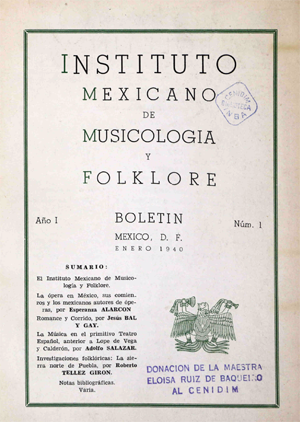Boletín del Instituto Mexicano de Musicología y Folklore
Prepared by Natalia Vilchis
Online only (2023)

The Mexican music journal Boletín del Instituto Mexicano de Musicología y Folklore [RIPM code BIM] was published in Mexico City on January 1940, a project of the Instituto Mexicano de Musicología y Folklore, founded in 1939 at the initiative of Luis Sandi. Its main goal was to “unify the efforts of researchers and concentrate material resources for the scientific investigation of musical matters.”[1] The Institute published only a single issue of the Boletín which includes articles by its committee members Esperanza Alarcón, Jesús Bal y Gay, Adolfo Salazar, Roberto Téllez Girón, Gerónimo Baqueiro Foster, and Carmen Monroy Niecke. Other scholars who also collaborated as part of the committee were Ignacio Helguera, Daniel Castañeda, and Otto Mayer.
Luis Sandi (1905-1996) served as the main editor of the journal. A composer, teacher, and prominent figure of the Mexican nationalistic musical movement that emerged in the 1920s, he aimed to create “true national music” influenced by the indigenous musical traditions. He was appointed director of the music department of the Instituto Nacional de Bellas Artes (Mexico City) in 1942, and throughout his life he held various important public positions and worked tirelessly to promote art and culture in Mexico.
The single issue of the Boletín contains 72 pages, with articles on topics such as the diffusion of opera in the Viceroyalty of New Spain, the evolution of early minstrelsy genres and its relation to the narrative literature of the sixteenth century, an analysis of the primitive Spanish theatre and its music, investigations on popular folk music of the north sierra in Mexico, and selected examples of Mexican musicological writings in the late nineteenth century. Of particular interest is a compilation of transcribed folk songs collected by Roberto Téllez Girón during research he directed in the states of Puebla and Veracruz.
The creation of the Institute took place during a rich artistic era in Mexico, when president Lázaro Cárdenas offered support to artists and encouraged the development of culture. He also provided political asylum to Spanish intellectuals who were exiled during the Spanish civil war, among these, the musicologist Adolfo Salazar (1890-1958) who contributed to the Boletín. A group of notable figures in music research participated in the creation of the Institute, including several distinguished Hispanic musicologists. However, the Institute had a short life, holding only one session on 22 August 1940, and it quickly dissolved that same year owing to disputes within the musical folklore guild. With the arrival of the Spanish musicologists to Mexico, a new interest emerged in discussing and defining the interests of the discipline of folklore in the Mexican musical sphere.
In the singular session of 1940, the Institute proposed to submit for discussion Jesús C. Romero’s “Observaciones acerca del término folklore” (1938-1940), in order to adopt or discard the definition of “Folklore” that was proposed there. The assembly turned into a heated discussion, which according to Romero himself, sometimes took the tone of "expressive", "vehement" and "sarcastic".[2] This dispute precipitated the failure of the Institute and its journal, the Boletín.
This RIPM Index was produced from a copy of the journal held by the Centro Nacional de Investigación, Documentación e Información Musical “Carlos Chávez” (Cenidim) in Mexico City.
[1] “Unificar los esfuerzos de los investigadores, (…) y concentrar los recursos musicales para la investigación científica de asuntos musicales” Boletín del Instituto Mexicano de Musicología y Folklore, no. 1 (Enero 1940)
[2] González, Alondra A. “Del Folklore Musical a la Etnomusicología en México: Esbozo Histórico de una Joven Disciplina.” Thesis, Universidad Nacional Autónoma De México, Escuela Nacional de Música 2010.
